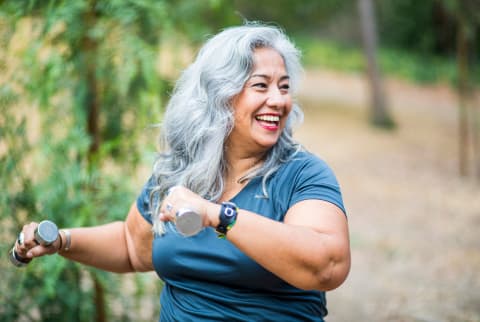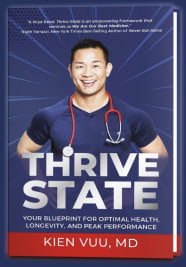The Best Workouts For Longevity & How Often To Do Them, From An MD


Do you sit at a desk all week and then commit to a 100-mile bike ride with your younger co-workers on the weekend? It may have sounded like a good idea (or not a really bad idea) at the time, but waking up on Monday morning...well, you've decided otherwise. The good news is that you're waking up (you didn't expire). Exercise is associated with lower mortality1, even for the weekend warrior who is active only one or two days per week.
A compelling study showed that one or two weekly sessions of moderate- or vigorous-intensity leisure/recreational activity was all that was necessary to reduce the risk of dying2 from cardiovascular disease (40%), cancer (18%), or something else (30%) compared with inactive individuals.
Weekend warriors are, however, more at risk for injuries3, including severe and fatal injuries, than individuals who exercise during the week. This could result from (1) prolonged physically demanding activity that exceeds one's exercise tolerance level, or (2) lower experience level with the activity. Generalized muscle soreness and lethargy may also be more common. A weekend warrior who experiences a debilitating injury (e.g., broken leg, strained back) may inadvertently become sedentary for an extended period of time.
If this describes you, take some common-sense precautions: Choose a few weekend activities to become skilled in doing; stretch and warm up before starting; get a good night's sleep before and after; stay adequately hydrated; wear the appropriate protective gear; and know your limits. And, if possible, do some light exercise during the week—even if that means taking the stairs at work instead of the elevator.
What type of movement/exercise is best?
The simplest (and honest) answer to this question is that the best exercise is the one that you'll actually do. It should really be something that you enjoy doing, particularly if the alternative is doing nothing. That being said, I'm going to review some forms of effective exercise here. Depending on your specific health goals and your current fitness level, select those activities that help move (pun intended) you toward your Thrive State.
Aerobic exercise
Aerobic exercise is defined as sustained physical activity of low to high intensity that stimulates and strengthens the heart and lungs to improve the body's utilization of oxygen; this is why aerobic exercise is sometimes called "cardio." With aerobic exercise, you will breathe harder and faster; your heart will beat quicker than when you are resting; and you'll likely begin to perspire. Aerobic activities involve the large muscle groups, particularly the legs, and are rhythmic in nature. Examples include walking, jogging, medium- to long-distance running, swimming, and cycling.
How often to do it
Resistance Training
Resistance training is defined as any exercise that involves muscles contracting against an external resistance or weight. These types of exercises increase muscle strength, tone, mass (size), and/or endurance (stamina). As a process, resistance exercises first break down or injure muscle cells (catabolism) and then repair, rebuild, and strengthen muscle cells (anabolism).
The "external resistance" in resistance training can be rubber resistance bands, dumbbells, weighted bars, kettlebells, water bottles, cans of vegetables, or your own body weight.
Depending on your goals, resistance training can be utilized for muscle definition—a tighter, more sculpted, and physically fit appearance. To "bulk up," more resistance or greater weight can be used. By increasing muscle mass, you'll increase your metabolism and burn more calories at rest; assuming that you don't eat any extra calories, you will lose fat mass. Your body weight may stay the same or go up slightly due to the extra muscle mass, but you'll notice a difference in how much better your clothes fit you.
After age 30, otherwise healthy individuals begin losing muscle mass—as much as 3 to 5% per decade thereafter. Many chronic diseases, including diabetes and obesity, are believed to accelerate the decline of both muscle mass and strength, thereby increasing the risk of sarcopenia and physical disability and decreasing health span4.
How often to do it
High Intensity Interval Training (HIIT)
HIIT is somewhat of a new exercise strategy designed for maximal fitness compressed into a short workout. It involves alternating cardiovascular exercise performed with all-out effort/intensity followed by a brief recovery period of less intense exercise; this cycling between exercise and recovery lasts until the individual is too exhausted to continue. Workouts are typically less than 30 minutes, which benefits people with limited time.
Exercises that work well with the HIIT model include a stationary bicycle, rowing machine, stair climbing, running, and uphill walking.
A common HIIT regimen entails a 2:1 ratio of intense activity to moderate (recovery) activity. For example, 40 seconds of an all-out, maximal-effort sprint alternated with 20 seconds of jogging or walking until exhaustion. Individuals of any cardiovascular fitness level can do a HIIT workout simply by modifying the activity and the time. A less fit person could alternate between 30 seconds of fast walking and 15 seconds of normal walking.
HIIT workouts improve athletic performance and as such, are beneficial for highly motivated professional and amateur athletes. Non-athletes experience significant health benefits as well, which are comparable or greater than those observed with moderate-intensity aerobic exercise. Studies of HIIT have demonstrated improved glucose metabolism5, especially in people with or at risk of developing Type 2 diabetes, decreased fat mass6, improved blood vessel function, and improved cardiovascular fitness7 as measured by maximal oxygen uptake.
How often to do it
Functional Movement
Functional movement is defined as the ability to move your body effortlessly and without pain. Proper muscle and joint functioning are key to biomechanically efficient movement that doesn't place any undue stress or create injury. Likewise, it's important to master functional movement before moving on to vigorous exercise so that the potential for injury is minimized.
In functional movement training, several muscle groups are worked simultaneously to achieve better coordination and neuromuscular control. When the body functions as a stable, singular unit, it moves more efficiently and with regular practice, elicits a lean and toned physique.
Functional movements include dead lifts, front squats, kettlebell swings, lunges, planks, and squat presses. A great online resource to help you with functional movement is Functional Movement Systems, which offers videos of specific exercises and describes the purpose of each.
Flexibility
Joint flexibility describes the range of movement in a joint (e.g., elbow, knee) or a series of joints (e.g., fingers, toes), and the lengthening of muscles that cross the joint when a bending movement occurs (e.g., bending over at the hip). Flexibility is the reason a baby can put its foot in its mouth, and although flexibility decreases as most people age, regular stretching, yoga, and Pilates can help maintain or improve flexibility. The more flexible one is, the lower the risk of musculoskeletal injury and debilitating pain. Additionally, the effects of a sedentary or stressful workday can be helped by occasional stretch breaks.
Play / Spontaneous Fun
As children, we didn't think running around in the yard was anything but fun, but as adults we must give ourselves permission to play and have fun playing. That is...if we remember how to play. Think back to your own childhood or look to your children for guidance—a game of hopscotch, Twister, Frisbee, basketball, or taking a turn on the jungle gym or merry-go-round. Play can be as light or strenuous as you make it and may burn a decent number of calories depending on the duration.
Dr. V's exercise regimen for thrive status
I based my exercise regimen on science, not fads, so it's the truth as we know it today. Anyone can adapt my basic exercise regimen to fit their lifestyle and achieve their Thrive State. The key components are (1) a weekly sprint at maximal effort; (2) resistance training with weights two days a week; (3) high-intensity interval training (HIIT) two days a week; and (4) low-level functional activity most days of the week. Here's how I put it all together:
- Monday: Weights + low-level functional movement
- Tuesday: HIIT + low-level functional movement
- Wednesday: Recovery + low-level functional movement
- Thursday: Weights + low-level functional movement
- Friday: HIIT + low-level functional movement
- Saturday: Play
- Sunday: A 20- to 30-second full-effort sprint (repeat 5+ times) + recovery
Excerpted from Thrive State, 2nd Edition: Your Blueprint for Optimal Health, Longevity, and Peak Performance by Kien Vuu, M.D., with permission from the publisher.

Dr. Kien Vuu is one of the most sought-after anti-aging physicians in the country. At his VuuMD Longevity and Performance Clinic, Dr. Vuu regularly works with celebrities, top corporate executives, and high-functioning professionals to optimize their health, performance, and vitality.
He’s also a health media personality, appearing on national TV shows such as The Doctors and Access Hollywood, and helps to train the next generation of physicians as assistant professor of health sciences at UCLA. As someone who has overcome two chronic diseases himself, Dr. Vuu is passionate about empowering people to reclaim their health and live with fulfillment, abundance, and purpose.
7 Sources
- https://www.ncbi.nlm.nih.gov/pmc/articles/PMC6295264/
- https://pubmed.ncbi.nlm.nih.gov/28097313/
- https://www.ncbi.nlm.nih.gov/pmc/articles/PMC4035407/
- https://pubmed.ncbi.nlm.nih.gov/24731660/
- https://pubmed.ncbi.nlm.nih.gov/26481101/
- https://www.ncbi.nlm.nih.gov/pmc/articles/PMC2991639/
- https://pubmed.ncbi.nlm.nih.gov/26243014/

